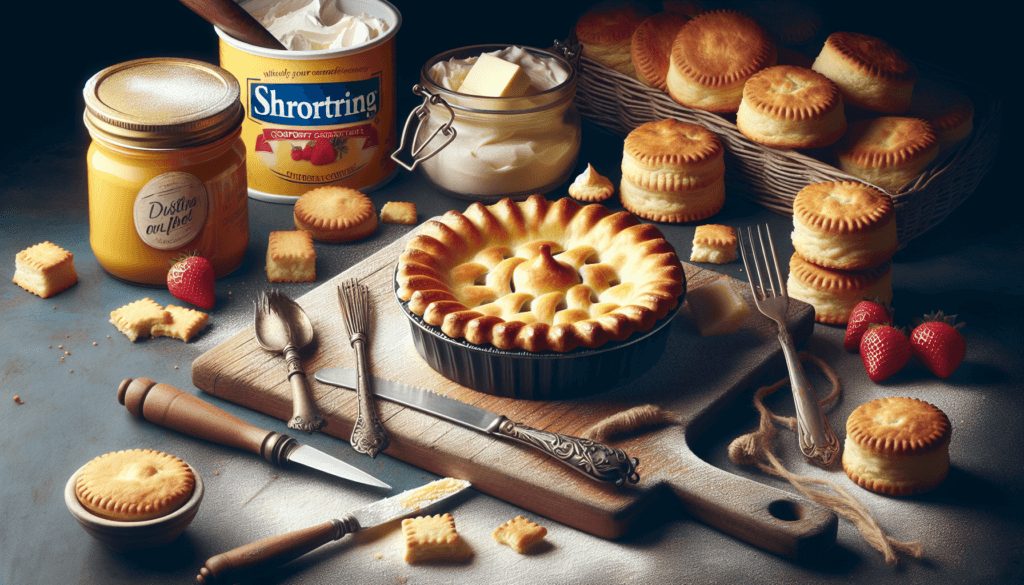Are you searching for the ultimate comfort food that will make your taste buds sing with delight? Look no further than dishes cooked with shortening! Whether you’re craving a warm and flaky pie crust, crispy fried chicken, or melt-in-your-mouth biscuits, shortening is the secret ingredient that will take your comfort food game to the next level. In this article, we will explore the magic of using shortening in your favorite recipes and uncover the delicious wonders it brings to the table. So get ready to indulge in the comforting goodness that only shortening can provide!

Benefits of Using Shortening in Comfort Food
Enhances Texture
Using shortening in comfort food recipes can greatly improve the texture of the final dish. Shortening has a higher melting point than butter, which means that it remains solid at room temperature. This solid state leads to the formation of air pockets when the shortening is mixed with flour, resulting in a lighter and fluffier texture. Whether you’re making biscuits, pie crusts, or even fried chicken, incorporating shortening into your recipes can take the texture of your comfort food to the next level.
Improves Flavor
Shortening is known for its neutral flavor, allowing the other ingredients in your comfort food to shine through. Unlike butter, which can have a distinct taste, shortening won’t overpower the flavors of your dish. This makes it a versatile choice for a wide range of comfort foods, from savory biscuits and gravy to sweet pie crusts. By using shortening, you can create dishes with a balanced and enhanced flavor profile that will leave you craving more.
Increases Shelf Life
One of the advantages of using shortening in comfort food is its ability to extend the shelf life of your dishes. Shortening has a lower water content compared to butter or margarine, which makes it less susceptible to spoilage. This can be especially beneficial for baked goods, as shortening helps to retain moisture, allowing them to stay fresh for a longer period of time. By incorporating shortening into your recipes, you can enjoy your favorite comfort foods for days after they’re made, without compromising on taste or quality.
Popular Comfort Foods Made with Shortening
Biscuits and Gravy
Biscuits and gravy is a classic comfort food dish that often relies on shortening to achieve that perfect flaky texture in the biscuits. Shortening is typically cut into the flour mixture, creating small pockets of fat that melt during baking, resulting in a light and tender biscuit. Combined with a flavorful sausage gravy, this comforting combination is a staple in many households.
Fried Chicken
When it comes to making crispy and flavorful fried chicken, shortening is often the secret ingredient. Its high smoke point allows for deep frying at higher temperatures, resulting in a golden and crispy exterior while keeping the meat juicy on the inside. Shortening is also favored by many chefs for its ability to add a rich and savory flavor to the chicken.
Pie Crusts
A flaky and buttery pie crust is essential for any comfort food lover, and shortening is frequently used to achieve that perfect texture. Shortening has the unique ability to create layers in pie crusts, giving them a light and delicate quality that pairs perfectly with sweet or savory fillings. Whether you’re making a classic apple pie or a savory quiche, shortening can help you create a pie crust that is both delicious and visually appealing.

Using Shortening as an Ingredient Substitute
Replacing Butter or Margarine
Shortening can be a great substitute for butter or margarine in comfort food recipes, especially in baking. It has a similar consistency to butter and can be used in equal amounts, making it a convenient replacement. However, it’s important to note that shortening does not contain water, unlike butter, so you might need to add a bit of water or another liquid to maintain the desired moisture level in your recipe.
Substituting Oil
In certain comfort food recipes, such as stir-fries or sautés, shortening can be used as a substitute for oil. It has a higher smoke point than some oils, allowing for higher heat cooking without the risk of burning. Shortening can also add a unique flavor to your dishes, enhancing the overall taste.
Tips for Incorporating Shortening in Comfort Food
Measuring Shortening Properly
When measuring shortening for your comfort food recipes, it’s important to know that its solid state can make it tricky to measure accurately. To ensure the right amount, use a sturdy spoon or a measuring cup specifically designed for shortening. Pack the shortening firmly into the spoon or cup, leveling off any excess with a straight edge. This method will ensure consistency and accurate measurements in your dishes.
Blending Ingredients
When incorporating shortening into your comfort food recipes, it’s essential to blend it properly with other ingredients. For baking recipes, it’s common to cut the shortening into the flour mixture using a pastry cutter or your fingers until it resembles coarse crumbs. This process helps distribute the fat evenly and creates those desired air pockets that contribute to the light and flaky texture.
Proper Storage
To maintain the quality and freshness of your shortening, it’s crucial to store it correctly. Shortening should be stored in an airtight container in a cool, dry place. Avoid exposing it to direct sunlight or high temperatures, as this can cause the shortening to become rancid more quickly. By storing your shortening properly, you can ensure its longevity and optimal performance in your comfort food recipes.

Health Considerations when Using Shortening
Moderation
While shortening can enhance the taste and texture of comfort foods, it’s important to consume it in moderation due to its high fat content. Like any indulgent ingredient, enjoy shortening-based dishes as a treat rather than a dietary staple. Being mindful of portion sizes and balancing your overall diet will help you enjoy the benefits of shortening while maintaining a healthy lifestyle.
Choosing Healthier Alternatives
If you’re concerned about the health implications of using shortening, there are alternative options available. Consider using vegetable spreads made from healthy oils, such as olive oil or avocado oil, as an alternative to traditional shortening. These spreads often contain less saturated fat and can offer additional nutritional benefits. However, it’s important to note that these alternatives may have different outcomes in terms of texture and flavor in your comfort food recipes, so experimenting with different substitutions is key.
Recipes for Comfort Food with Shortening
Classic Shortening Chocolate Chip Cookies
Ingredients:
- 1 cup shortening
- 1 cup granulated sugar
- 1 cup packed brown sugar
- 2 eggs
- 2 teaspoons vanilla extract
- 3 cups all-purpose flour
- 1 teaspoon baking soda
- 1 teaspoon salt
- 2 cups chocolate chips
Instructions:
- Preheat the oven to 375°F (190°C).
- In a large bowl, cream together the shortening, granulated sugar, and brown sugar until light and fluffy.
- Beat in the eggs and vanilla extract.
- In a separate bowl, whisk together the flour, baking soda, and salt.
- Gradually add the dry ingredients to the wet ingredients, mixing until just combined.
- Stir in the chocolate chips.
- Drop rounded tablespoons of dough onto ungreased baking sheets.
- Bake for 8-10 minutes, or until golden brown.
- Allow the cookies to cool on the baking sheets for a few minutes before transferring them to a wire rack to cool completely.
Flaky Buttermilk Biscuits
Ingredients:
- 2 cups all-purpose flour
- 1 tablespoon baking powder
- 1/2 teaspoon salt
- 1/2 cup shortening
- 3/4 cup buttermilk
Instructions:
- Preheat the oven to 450°F (230°C).
- In a large bowl, whisk together the flour, baking powder, and salt.
- Cut in the shortening using a pastry cutter or your fingers until the mixture resembles coarse crumbs.
- Make a well in the center of the dry ingredients and pour in the buttermilk.
- Stir until the dough just comes together.
- Turn the dough out onto a lightly floured surface and knead it gently a few times.
- Roll out the dough to a 1/2-inch thickness.
- Use a biscuit cutter to cut out biscuits and place them on an ungreased baking sheet.
- Bake for 10-12 minutes, or until the biscuits are golden brown.
- Serve warm with butter or your favorite comfort food dish.
Creamy Mashed Potatoes
Ingredients:
- 4 pounds russet potatoes, peeled and cut into chunks
- 1/2 cup shortening
- 1/2 cup unsalted butter
- 1 cup milk, warmed
- Salt and pepper, to taste
Instructions:
- Place the potato chunks in a large pot and cover them with cold water.
- Bring the water to a boil over high heat and cook the potatoes until they are tender when pierced with a fork.
- Drain the potatoes and return them to the pot.
- Add the shortening and butter to the pot and mash the potatoes using a potato masher or an electric mixer.
- Gradually add the warmed milk to the potatoes, beating until smooth and creamy.
- Season the mashed potatoes with salt and pepper, adjusting to taste.
- Serve the creamy mashed potatoes as a side dish with your favorite comfort food, or enjoy them on their own.

Exploring Shortening Varieties
Vegetable Shortening
Vegetable shortening is the most commonly used type of shortening in comfort food recipes. It is made from hydrogenated vegetable oils and often contains additives such as emulsifiers and stabilizers. Vegetable shortening has a high smoke point, which makes it ideal for frying and baking. It is a versatile ingredient that can be used in a wide range of comfort food dishes.
All-Shortening Margarine
All-shortening margarine is a type of margarine that is made entirely from vegetable shortening. It is a dairy-free alternative to butter that can be used in comfort food recipes. All-shortening margarine has a similar consistency to butter and can be used interchangeably in recipes that call for butter or margarine. It offers the added benefit of a longer shelf life and is a suitable option for those who are lactose intolerant or following a vegan diet.
Frequently Asked Questions about Shortening in Comfort Food
Is Shortening the Same as Lard?
No, shortening and lard are not the same. While both are solid fats commonly used in cooking and baking, lard is made from rendered pig fat, while shortening is made from vegetable oils. They have different flavors and compositions, so they may not be interchangeable in all recipes. However, lard can be a suitable substitute for shortening in some comfort food dishes, especially those with a savory profile.
Can I Freeze Shortening?
Yes, shortening can be frozen for extended storage. If you have a large quantity of shortening or want to prolong its shelf life, you can freeze it in an airtight container or freezer bag. Frozen shortening can be thawed in the refrigerator before using, and it should maintain its quality and performance once thawed. It’s important to note that freezing and thawing may affect the texture of shortening, so it may be best to reserve frozen shortening for baking rather than other cooking methods.
Can Shortening Be Used in Non-Baked Comfort Foods?
Although shortening is commonly used in baking, it can also be used in non-baked comfort foods. For example, shortening can be used for pan-frying or sautéing, providing a rich flavor and a crispy texture to dishes like fried chicken or stir-fried vegetables. With its high smoke point, shortening can withstand higher temperatures without burning, making it a versatile option for various cooking methods.

Experimenting with Shortening in International Comfort Food
Shortening in Indian Cuisine
In Indian cuisine, shortening can be used to enhance the texture and flavor of various comfort food dishes. For example, shortening can be incorporated into the dough for samosas, resulting in a crispy and flaky crust. It can also be used in roti or paratha recipes, giving the bread a softer texture and adding a rich and buttery taste. Shortening can be a valuable ingredient for recreating traditional Indian comfort foods with a delightful twist.
Shortening in Asian Stir-Fries
Shortening can be a game-changer when it comes to stir-frying Asian comfort food dishes. Its high smoke point allows for better heat distribution and faster cooking, resulting in dishes with a lovely caramelized flavor. Whether you’re stir-frying vegetables, noodles, or tofu, incorporating shortening can give your dish a unique richness and a satisfying mouthfeel. Get creative with your favorite stir-fry recipes and experience the difference shortening can make.
Conclusion
Shortening can be a valuable ingredient when it comes to preparing comforting and delicious dishes. From enhancing texture and flavor to increasing shelf life, shortening offers numerous benefits for a wide range of comfort food recipes. Whether you’re making biscuits and gravy, fried chicken, or pie crusts, incorporating shortening can take your dishes to new heights. By understanding its uses, tips for incorporating it properly, and considering health considerations, you can confidently experiment with shortening in your favorite comfort food recipes. So go ahead, indulge in the irresistible taste and texture that shortening brings to the table. Happy cooking and enjoy your comforting creations!


